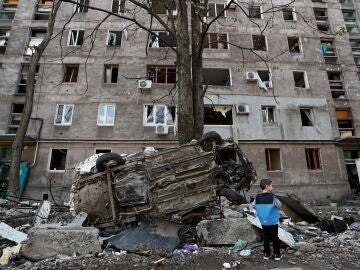
A dozen Ukrainian prisoners of war already released have denounced having been victims of torture in the Russian detention center in which they were, in the city of Taganrog, located on the shores of the Azov Sea. In interviews with the BBC, conducted over several weeks, former Russian prisoners released in prisoner exchangesdescribe what the chain defines as “a pattern of extreme violence and ill-treatment” in the facilities.
Among the accusations leveled at the Russian authorities at the detention center are the continuous beatings, both men and women, and the electric shocks and daily interrogations; threats by the guards and constant intimidation of the detainees; malnutrition in the center and lack of health care for the wounded and even the death of some of them.
From the BBC they maintain that they have not been able to “independently” verify all these affirmations, but they indicate that many testimonies were corroborated by other detainees. The Russian government has not allowed any outside body (neither the United Nations nor the International Committee of the Red Cross) visit these facilities which, before the war, were used only for national prisoners.
More than 2,500 Ukrainians have been released since the start of the war between Russia and Ukrainea year and a half ago, but it is believed that another 10,000 people could still be imprisoned in Russia, according to reports from organizations in defense of Human Rights.
“Here you will rot until the end of your lives”
One of the complainants is Artem Seredniak, who was transferred to this prison after spending four months in the hands of the Russians. He assures that they traveled in a truck for hours, not knowing where they were going, blindfolded and tied to each other by the arms, like a “human centipede”. Arriving in Taganrog, he claims that an officer asked the new arrivals: “Do you know where you are? Here you will rot until the end of your lives.” There, he recounts he, the beat on the legs and arms at all times, in what the Russians called “reception”.
At one point, Seredniak says that they asked him if he had a girlfriend and asked for his Instagram account to send him a photo of the captive, which, he says, he refused. He says that until they received the information they wanted, they did not stop beating the prisoners. Another of the now released prisoners, Serhii Rotchuk, recounts how they were looking for swastikas tattooed, although they already considered you a “bad guy” when they saw any tattoo. Rotchuk maintains that they lived “in a state of permanent stress”, receiving electric shocks and being sent to isolation for several weeks.
There, many were forced to confess to crimes they had not committed. Last June, Amnesty International covered a case of torture, unrelated to the conflict in Ukraine, and recounted some of the mistreatment to which prisoners are subjected in Russia. But in relation to the war, it is nothing new either: a UN observer mission corroborated at the end of 2022, “with a considerable margin of certainty”, a series of torture to which Ukrainians were subjectedranging from burns to beatings, including electric shocks.
Weeks later, the Ukrainian Police claimed to have located up to 25 facilities used to torture prisoners held by Russian forces in the Kharkiv region, where “civilians held in inhumane conditions” were tortured. Shortly before, Ukraine had found a torture chamber in the police station of a liberated city.
Source: Lasexta
Ricardo is a renowned author and journalist, known for his exceptional writing on top-news stories. He currently works as a writer at the 247 News Agency, where he is known for his ability to deliver breaking news and insightful analysis on the most pressing issues of the day.











